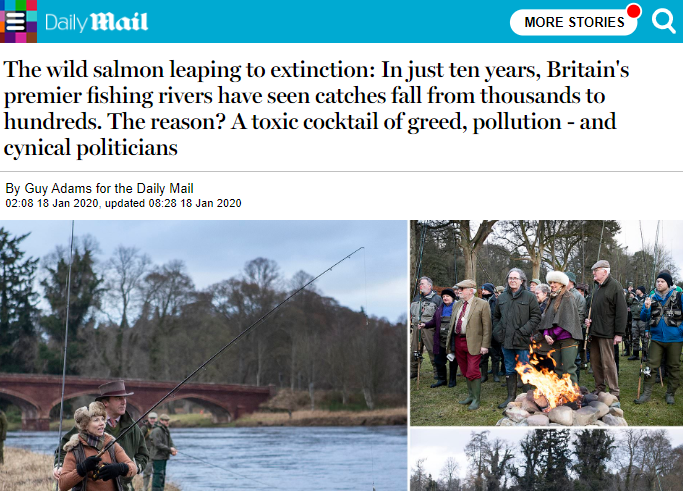 Villtur lax er nánast horfinn úr fjölmörgum ám á Bretlandseyjum. Ástæðurnar eru rányrkja, súrnun sjávar, vatnsföllum hefur verið spillt af manna völdum og síðast en ekki síst sjókvíaeldi.
Villtur lax er nánast horfinn úr fjölmörgum ám á Bretlandseyjum. Ástæðurnar eru rányrkja, súrnun sjávar, vatnsföllum hefur verið spillt af manna völdum og síðast en ekki síst sjókvíaeldi.
Óttast er að ekki verði aftur snúið. Að baráttan sé töpuð og villtur lax muni deyja út í lífríki Bretlandseyja af völdum græðgi mannsins. Grátlegt er að horfa upp á sama hugarfar birtast hér á landi. Skeytingarleysið og kaldlyndið gagnvart náttúrunni og lífríkinu er algjört.
Úr frétt Daily Mail: „Overall numbers are down by 70 per cent since the turn of the century, falling from around ten million to between two and three million.
Before Christmas, they reached what scientists dubbed ‘critical’ levels, and in some rivers, particularly farther south, the species is already on the verge of extinction.
Professor Carlos Garcia de Leaniz, an expert in aquatic biosciences at Swansea University, has compared the plight of wild salmon to critically endangered species such as the black rhino.
‘It’s a scandal, an absolute scandal,’ he said. ‘To think that something that has been part of our culture for perhaps 100,000 or 200,000 years can disappear in a matter of a few decades is just tragic. It is absolutely tragic.’ …
To understand this growing crisis, one must first appreciate the salmon’s remarkable life cycle. Born in small streams, they spend their early years in fresh water, before heading out to sea, where they attempt to travel to remote feeding grounds as far away as Iceland and Greenland.
The fish then return as adults, often years later, using extraordinary powers of navigation to find the exact river where they were born.
They then swim upriver through rapids and occasionally leaping waterfalls in order to reach remote spawning grounds, in a spectacle which inspired their scientific name Salmo Salar — Latin for ‘leaper’.
For thousands of years, this natural cycle has continued, with between 20 and 25 per cent of the juvenile salmon (or ‘smolts’) that venture out to sea coming back to reproduce (the rest are caught or eaten by predators).
But in recent years, return rates have fallen dramatically, and, today, they sit at below 5 per cent. Scientists believe that’s not enough for the species to survive.“
